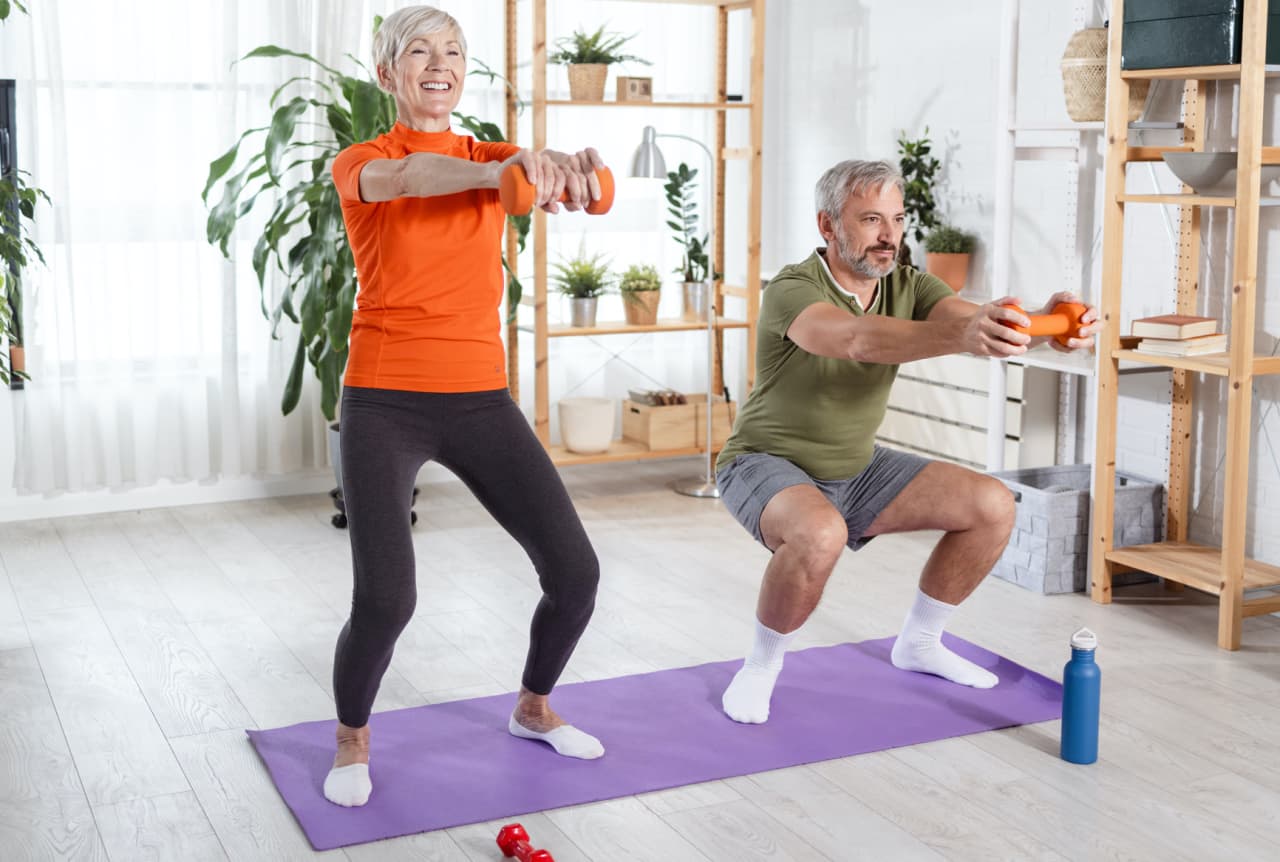A groundbreaking new study in the British Journal of Sports Medicine also shows that regular exercise, such as strength training, is up to one and a half times more effective than medication or therapy in treating depression, anxiety and stress.
One type of strength training, in particular, that offers a range of benefits for older adults is functional strength training. I spoke with strength coach for seniors, Ren Collier, NASM, CPT, about his experience using functional strength training to help his clients achieve amazing results at all ages.
Collier talked about how this strength training exercise can help build muscle, prevent injuries, and keep you moving longer.
Why strength training is crucial after age 50
“There was a time not so long ago when we thought strength training was dangerous for athletes,” Collier says. “And now, there is not a college or professional athlete anywhere who is not using weightlifting to support their athletic performance. I think we will look at strength training for people over 50 similarly in the future.”
Research supports this idea as a growing body of evidence shows tremendous benefits of strength training for people of all ages, especially older adults. One aspect of health that improves dramatically through regular strength training is grip strength.
Grip strength is so reliably linked to overall physical strength and so many measures of longevity that scientists want to use as a biomarker (a way to measure overall health). As we age, if we do not regularly engage in endurance and resistance exercises such as strength training, we lose 3-5% of our muscle every decade after the age of 50.
These cumulative losses can lead to injury, disability, and loss of independence, so building and maintaining muscle and bone density throughout the lifespan is critical.
is reading: When I was 65, I thought I could eat whatever I wanted, until I woke up in the intensive care unit
What is functional strength training?
Functional strength training takes many of the benefits of other forms of resistance training and raises them to a higher level.
As a personal trainer for over 10 years who also trains people over the age of 50, I can enthusiastically tell you that functional strength movements are at the center of every one of my clients' programs, and for good reason.
But what is functional strength training? What makes it superior? In fact, functional strength training is just a descriptive term without a single definition. However, most strength coaches agree that functional strength training has the following distinguishing features:
-
It incorporates all seven natural human movement patterns: push, pull, squat, hinge, lunge, twist, and carry.
-
It uses the full range of motion
-
It emphasizes unilateral and anti-rotational movements
-
It is designed to prepare the individual for the demands of his or her daily life
“Functional training is a term that has been hijacked over the years, but at its core, it's about preparing people for the activities they'll encounter every day. So functional training is going to look different for everyone,” Collier says.
Humans are built to move, and we perform many of the same movement patterns throughout the day, even if we don't realize it.
You squat when getting up from a chair, and squat when you bend over to pick something up from the floor at your feet. You carry groceries, kids or baskets. You twist to grab an item from the side.
Functional strength training better prepares you for your daily job and keeps you moving longer. This means choosing heavy compound movements using free weights — such as squats, deadlifts, farmer's holds and lunges — over stationary machines and light weights.
See also: Can you run after the age of 50? These coaches, runners, and physical therapists say you can and you should. Here's how to do it safely.
Collier says that in his experience, most people over 50 — especially women — dramatically underestimate their abilities. While you may see some progress using light weights at first, you will need to continue increasing the difficulty of your workouts to see results and build muscle.
“The rules of overload are progressive, regardless of age, gender, or anything else. This means that we must continue to increase our training motivation over time. Keep training hard, and you will be amazed at what you can achieve,” says Collier.
Throughout his nearly 15 years of training, Collier has witnessed people over 50 achieve impressive feats like performing their first strict push-up or pull-up, lifting hundreds of pounds and squatting, and even competing in grueling competitions like the Spartan Race.
Some functional strength exercises
-
Squatting
-
Deadlift
-
Bench press
-
Above pressure
-
Farmer holds
-
Stabs
-
Palouf Press
-
Pull ups
-
Push-ups
-
the classes
-
Throws
-
Planks
-
Cossack squatting
-
90/90 hip opener
-
Turkish renaissance
-
Step ups
-
Jumping
-
Inch worm
-
Bear crawled
Risks versus benefits of functional strength training
Collier knows that many may feel skeptical about starting a strength training program as an adult. However, he says the risks and outcomes are much worse for sedentary people than for people who regularly participate in structured exercise, even those with prior injuries or chronic pain.
“You may think you can't squat because of knee pain. But oftentimes, in my experience, a tailored and precise strength program is exactly what you need to get rid of knee pain and improve your quality of life,” Collier says.
The key, he says, is to work with an experienced coach who will do a comprehensive assessment and give you a specialized program that supports you where you currently are but also gets you where you want to go.
You may like: How to keep cycling into your 50s, 60s and 70s
Begin functional strength training
If you want to start enjoying the amazing benefits of functional strength training today, Collier shared the following tips for getting started and staying safe.
Talk to your health care provider first
If you have injuries or are taking multiple medications, it is always a good idea to talk to your doctor to see if you have any restrictions.
They may want to see another health professional, such as a physiotherapist, before allowing you to exercise.
Find an experienced strength coach
Not everyone knows how to train functional movement patterns or work with people over 50, especially those with unique training needs.
Make sure they are certified, comfortable with functional exercise training, and have a proven track record with people over 50.
Start where you are
No matter your current physical fitness or level of function, you can and should move however your body allows.
Beginners can see significant progress with bodyweight exercises and walking, so get moving and find an exercise professional who can guide your progress.
Embrace strength at every age
When it comes to strength, age is just a number. You'll be amazed at what you can achieve and what your body is capable of.
Getting started is the hardest part, so find a community that supports you and get moving.
Plus: Is skiing safe after the age of 50? Here are some tips from coaches so you can keep skiing on the slopes into old age
Meg Lambrich has 14 years of experience as a registered nurse and personal trainer, and now uses that experience as a health reporter in the digital space. Lambrich earned her bachelor's degree in health and exercise science from Syracuse University and her bachelor of science in nursing from the University of Rochester. She believes that all conversations about health and fitness should be rooted in understanding the complex and nuanced reality of access to food and health care and how these limitations impact our health.
This article is reprinted with permission from NextAvenue.org©2024 Twin Cities Public Television, Inc. all rights are save.
More from Avenue Next:


